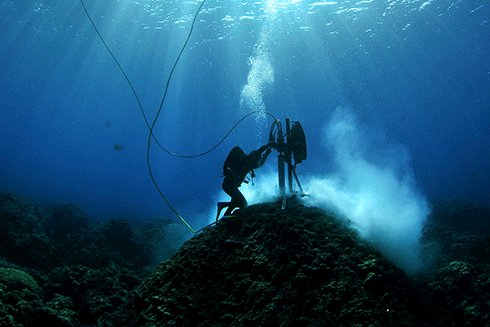
|
Published: 7 April 2014
Corals reveal effects of La Niña in the Pacific on Indian Ocean
A new study published in the international journal Nature Communications has revealed how Western Australia's coral reefs have been affected by changing ocean currents, rising sea surface temperatures and sea level variability.

|
|
A researcher from AIMS (WA) coring corals in the Indian Ocean. Credit:
Eric Matson
|
Scientists from The University of Western Australia (UWA), the Australian Institute of Marine Science (AIMS), CSIRO and the University of San Diego analysed coral cores from the eastern Indian Ocean to understand how the unique coral reefs of Western Australia were affected by changing ocean currents and water temperatures.
The findings reported in the paper ‘Corals record long-term Leeuwin current variability including Ningaloo Niño/Niña since 1795’ give new insights into how La Niña, a climate swing in the tropical Pacific, affects the Leeuwin current and how our oceans are changing.
Assistant Professor Jens Zinke, who holds a collaborative fellowship with UWA's Indian Ocean Marine Research Centre, the Australian Institute of Marine Science (AIMS) and CSIRO, said the researchers examined long coral records, enabling them to look at patterns of climate variability dating back to 1795.
‘Due to the lack of long-term observations of marine climate we used long coral cores, with annual growth bands similar to tree rings, to provide a record of the past,’ Professor Zinke said.
‘We obtained records of past sea temperatures by measuring the chemical composition of the coral skeleton from year to year. This showed how changing winds and ocean currents in the eastern Indian Ocean, are driven by climate variability in the western tropical Pacific Ocean.’
La Niña events in the tropical Pacific result in a strengthened Leeuwin Current and unusually warm water temperatures and higher sea levels off south-west Western Australia.
UWA Adjunct Associate Professor and CSIRO Principal Research Scientist Dr Ming Feng said a prominent example of the effects of La Niña was the 2011 heatwave along WA's reefs which led to coral bleaching and fish kills.
The international team found that in addition to warming sea surface temperatures, sea-level variability and Leeuwin Current strength had increased since 1980. The coral cores also revealed that strong winds and extreme weather off Western Australia in 2011 were highly unusual in the context of the past 215 years.
The researchers used core samples of massive Porites colonies from the Houtman-Abrolhos Islands, the most southerly reefs in the Indian Ocean, which are directly in the path of the Leeuwin Current. Using the chemical composition of the annual coral growth bands they were able to reconstruct sea surface temperature and Leeuwin Current for 215 years, from 1795 to 2010.
The authors concluded this was clear evidence that global warming and sea-level rise was increasing the severity of these extreme events which impact the highly diverse coral reefs of Western Australia, including the Ningaloo Reef World Heritage site.
Source: UWA



